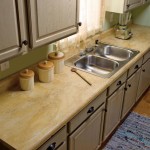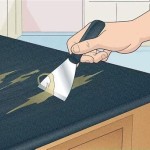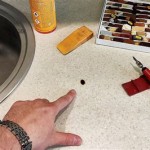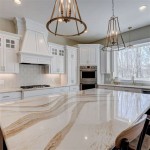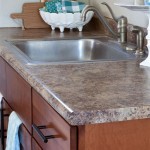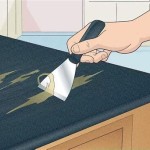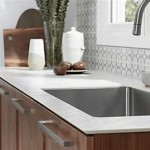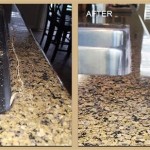Epoxy Paint for Kitchen Countertops: A Comprehensive Overview
Epoxy paint, a thermosetting polymer, has gained significant traction as a surface coating for kitchen countertops. Its appeal lies in the combination of durability, aesthetic versatility, and relatively straightforward application process, making it a viable alternative to traditional countertop materials like granite, quartz, or laminate. This article provides an in-depth examination of epoxy paint for kitchen countertops, exploring its properties, application techniques, advantages, disadvantages, and considerations for long-term maintenance.
The term "epoxy paint" is often used interchangeably with "epoxy resin," although technically, it is a formulation containing epoxy resins, pigments, hardeners, and other additives. These components react chemically when mixed, creating a rigid, cross-linked structure that delivers the desired properties. The specific characteristics of the final epoxy coating will depend on the type of epoxy resin used, the hardener chosen, and the inclusion of any modifying agents.
Understanding the Properties of Epoxy Paint
The suitability of epoxy paint for kitchen countertops is primarily determined by its inherent properties. These properties are crucial for withstanding the demands of a typical kitchen environment and maintaining its aesthetic appeal over time.
One of the most significant attributes of epoxy paint is its exceptional durability. The cross-linked polymer network formed during the curing process results in a hard, impact-resistant surface. This resistance to impact minimizes the risk of chipping, cracking, or scratching, which are common concerns with other countertop materials. The hardness also contributes to the paint's ability to withstand heavy objects and everyday wear and tear.
Chemical resistance is another key characteristic that makes epoxy paint attractive for kitchen countertops. Epoxy coatings are inherently resistant to a wide range of chemicals, including acids, bases, solvents, and common household cleaners. This resistance ensures that the countertop surface remains unaffected by spills from food preparation, cleaning agents, or other substances typically encountered in a kitchen setting. The impervious surface also prevents staining, a major advantage over porous materials like natural stone.
Water resistance is paramount for any kitchen countertop material. Epoxy paint, when properly applied and cured, forms a seamless, non-porous barrier that prevents water penetration. This prevents water damage to the underlying substrate, such as wood or laminate, and inhibits the growth of mold and mildew, which are common concerns in damp kitchen environments.
Finally, epoxy paint offers considerable aesthetic flexibility. It can be tinted to virtually any color, allowing for customization to match specific kitchen design schemes. Beyond solid colors, epoxy can be blended with metallic pigments, glitter, or other decorative materials to create unique visual effects. The ability to embed objects, such as stones, glass, or even photographs, within the epoxy layer further enhances the creative possibilities for countertop design.
Application Techniques for Epoxy Countertops
Achieving a durable and aesthetically pleasing epoxy countertop requires careful planning, proper preparation, and meticulous application. The process typically involves several key steps, each critical to the success of the project.
Surface preparation is arguably the most important step. The existing countertop surface must be thoroughly cleaned and degreased to remove any contaminants that could interfere with the epoxy's adhesion. This typically involves scrubbing with a strong detergent, followed by rinsing with clean water. Any loose or damaged areas need to be repaired and sanded smooth. For laminate countertops, lightly sanding the entire surface can create a better bonding surface for the epoxy.
Priming the countertop is often recommended, especially for porous surfaces like wood. A primer helps to seal the substrate and provide a uniform base for the epoxy coating. Choose a primer specifically designed for use with epoxy resins, and ensure it is fully cured before proceeding to the next step. Some epoxy systems are self-priming, but it is wise to consult the manufacturer’s instructions.
The epoxy mixing process must be precise, following the manufacturer's instructions regarding the resin-to-hardener ratio. Deviations from the recommended proportions can lead to improper curing, resulting in a soft, tacky, or brittle finish. The mixing should be thorough but gentle to avoid introducing air bubbles into the mixture. Air bubbles can compromise the appearance and structural integrity of the finished countertop.
Applying the epoxy involves pouring the mixed resin onto the countertop surface and spreading it evenly using a squeegee or notched trowel. Multiple thin coats are generally preferred over a single thick coat, as they allow for better control and minimize the risk of bubbles or imperfections. Each coat must be allowed to cure completely before applying the next. The curing time will vary depending on the specific epoxy formulation and the ambient temperature and humidity.
During the curing process, it is essential to protect the countertop from dust and debris. Covering the area with plastic sheeting can help to maintain a clean environment and prevent contamination. Regular inspection during curing allows for the timely removal of any stray particles that may have landed on the surface.
Sanding and polishing are often required to achieve a smooth, glossy finish. Fine-grit sandpaper can be used to remove any imperfections or orange-peel texture. Polishing compounds and buffing pads can then be used to enhance the shine and clarity of the epoxy coating. The sanding and polishing process should be performed carefully to avoid scratching or damaging the surface.
Advantages and Disadvantages of Epoxy Countertops
The suitability of epoxy paint for kitchen countertops depends on a careful consideration of its advantages and disadvantages relative to other countertop materials.
One of the primary advantages of epoxy countertops is their cost-effectiveness. Compared to granite, quartz, or solid surface materials, epoxy can be a more budget-friendly option, especially for DIY enthusiasts. The material costs are generally lower, and the installation process can be completed without the need for specialized tools or professional expertise, potentially saving on labor costs.
The ease of customization is another significant benefit. Epoxy can be tinted to any color, and decorative elements can be readily incorporated into the coating. This allows for a high degree of personalization, enabling homeowners to create unique and visually striking countertops that perfectly complement their kitchen décor.
Durability and chemical resistance, as previously discussed, are also crucial advantages. Epoxy countertops can withstand the rigors of daily use and resist staining from common kitchen spills. This ensures that the countertops maintain their appearance and functionality for years to come.
However, epoxy countertops also have some limitations. One potential drawback is the complex application process. Achieving a flawless finish requires careful preparation, precise mixing, and meticulous application. Improper technique can result in imperfections such as bubbles, uneven surfaces, or cloudiness, which can detract from the overall appearance of the countertop.
Heat resistance is another area of concern. While epoxy is generally heat-resistant, it is not as heat-resistant as materials like granite or quartz. Placing hot pots or pans directly on an epoxy countertop can cause discoloration or even damage the coating. It is therefore essential to use trivets or cutting boards to protect the surface from excessive heat.
The long-term durability of epoxy countertops can also be a factor. While epoxy is generally durable, it can be susceptible to scratching or abrasion over time. Frequent use of abrasive cleaners or scouring pads can dull the surface and compromise its aesthetic appeal. Proper maintenance and the use of appropriate cleaning products are crucial for preserving the appearance of epoxy countertops.
Ultraviolet (UV) light exposure can also affect epoxy countertops. Some epoxy formulations are prone to yellowing or discoloration when exposed to prolonged sunlight. To mitigate this issue, it is important to choose an epoxy resin that is specifically formulated to be UV-resistant or to apply a UV-resistant topcoat to protect the surface.
Finally, the DIY nature of most epoxy countertop installations can lead to variable results. While many homeowners successfully install epoxy countertops themselves, others may find the process challenging or time-consuming. Hiring a professional installer can ensure a high-quality finish, but this will increase the overall cost of the project.
In summary, epoxy paint offers a compelling option for kitchen countertops due to its durability, aesthetic versatility, and relative affordability. However, careful consideration must be given to the application process, heat resistance, and long-term maintenance requirements to ensure the successful implementation and longevity of epoxy countertops. By understanding the properties, application techniques, advantages, and disadvantages of epoxy paint, homeowners can make informed decisions about its suitability for their kitchen.

How To Make White Kitchen Countertops With Epoxy

What Is The Downside To An Epoxy Countertop

Advantages Disadvantages Of Epoxy Countertops

Beginner S Guide To Building New Epoxy Kitchen Countertops

White Marble Epoxy Countertop Kit Full Diy Instructional To Upgrade Your Kitchen Builds By Maz

Epoxy Countertops A Beginner S Guide

Advantages Disadvantages Of Epoxy Countertops
Easy Diy Epoxy Countertops Step By Guide Full Hearted Home

Transform Kitchen Countertops With Epoxy Paint Surprisingly Easy

Diy Kitchen Countertop Makeover

